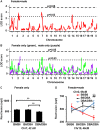Genetic architecture of atherosclerosis dissected by QTL analyses in three F2 intercrosses of apolipoprotein E-null mice on C57BL6/J, DBA/2J and 129S6/SvEvTac backgrounds
- PMID: 28837567
- PMCID: PMC5570285
- DOI: 10.1371/journal.pone.0182882
Genetic architecture of atherosclerosis dissected by QTL analyses in three F2 intercrosses of apolipoprotein E-null mice on C57BL6/J, DBA/2J and 129S6/SvEvTac backgrounds
Abstract
Quantitative trait locus (QTL) analyses of intercross populations between widely used mouse inbred strains provide a powerful approach for uncovering genetic factors that influence susceptibility to atherosclerosis. Epistatic interactions are common in complex phenotypes and depend on genetic backgrounds. To dissect genetic architecture of atherosclerosis, we analyzed F2 progeny from a cross between apolipoprotein E-null mice on DBA/2J (DBA-apoE) and C57BL/6J (B6-apoE) genetic backgrounds and compared the results with those from two previous F2 crosses of apolipoprotein E-null mice on 129S6/SvEvTac (129-apoE) and DBA-apoE backgrounds, and B6-apoE and 129-apoE backgrounds. In these round-robin crosses, in which each parental strain was crossed with two others, large-effect QTLs are expected to be detectable at least in two crosses. On the other hand, observation of QTLs in one cross only may indicate epistasis and/or absence of statistical power. For atherosclerosis at the aortic arch, Aath4 on chromosome (Chr)2:66 cM follows the first pattern, with significant QTL peaks in (DBAx129)F2 and (B6xDBA)F2 mice but not in (B6x129)F2 mice. We conclude that genetic variants unique to DBA/2J at Aath4 confer susceptibility to atherosclerosis at the aortic arch. A similar pattern was observed for Aath5 on chr10:35 cM, verifying that the variants unique to DBA/2J at this locus protect against arch plaque development. However, multiple loci, including Aath1 (Chr1:49 cM), and Aath2 (Chr1:70 cM) follow the second type of pattern, showing significant peaks in only one of the three crosses (B6-apoE x 129-apoE). As for atherosclerosis at aortic root, the majority of QTLs, including Ath29 (Chr9:33 cM), Ath44 (Chr1:68 cM) and Ath45 (Chr2:83 cM), was also inconsistent, being significant in only one of the three crosses. Only the QTL on Chr7:37 cM was consistently suggestive in two of the three crosses. Thus QTL analysis of round-robin crosses revealed the genetic architecture of atherosclerosis.
Conflict of interest statement
Figures




Similar articles
-
Identification of aortic arch-specific quantitative trait loci for atherosclerosis by an intercross of DBA/2J and 129S6 apolipoprotein E-deficient mice.PLoS One. 2015 Feb 17;10(2):e0117478. doi: 10.1371/journal.pone.0117478. eCollection 2015. PLoS One. 2015. PMID: 25689165 Free PMC article.
-
Quantitative trait loci affecting atherosclerosis at the aortic root identified in an intercross between DBA2J and 129S6 apolipoprotein E-null mice.PLoS One. 2014 Feb 20;9(2):e88274. doi: 10.1371/journal.pone.0088274. eCollection 2014. PLoS One. 2014. PMID: 24586312 Free PMC article.
-
Aortic arch curvature and atherosclerosis have overlapping quantitative trait loci in a cross between 129S6/SvEvTac and C57BL/6J apolipoprotein E-null mice.Circ Res. 2010 Apr 2;106(6):1052-60. doi: 10.1161/CIRCRESAHA.109.207175. Epub 2010 Feb 4. Circ Res. 2010. PMID: 20133902 Free PMC article.
-
Use of recombinant inbred strains for studying genetic determinants of responses to alcohol.Alcohol Alcohol Suppl. 1994;2:67-71. Alcohol Alcohol Suppl. 1994. PMID: 8974318 Review.
-
Genetic and genomic insights into the molecular basis of atherosclerosis.Cell Metab. 2007 Sep;6(3):164-79. doi: 10.1016/j.cmet.2007.07.001. Cell Metab. 2007. PMID: 17767904 Free PMC article. Review.
Cited by
-
Reduction of Stabilin-2 Contributes to a Protection Against Atherosclerosis.Front Cardiovasc Med. 2022 Mar 11;9:818662. doi: 10.3389/fcvm.2022.818662. eCollection 2022. Front Cardiovasc Med. 2022. PMID: 35360009 Free PMC article.
-
Mapping Quantitative Trait Loci Associated With Graft (In)Compatibility in Apricot (Prunus armeniaca L.).Front Plant Sci. 2021 Feb 19;12:622906. doi: 10.3389/fpls.2021.622906. eCollection 2021. Front Plant Sci. 2021. PMID: 33679836 Free PMC article.
-
Ectopic expression of the Stabilin2 gene triggered by an intracisternal A particle (IAP) element in DBA/2J strain of mice.Mamm Genome. 2020 Feb;31(1-2):2-16. doi: 10.1007/s00335-019-09824-1. Epub 2020 Jan 7. Mamm Genome. 2020. PMID: 31912264 Free PMC article.
-
The Genetic Elements of the Obesity Paradox in Atherosclerosis Identified in an Intercross Between Hyperlipidemic Mouse Strains.Int J Mol Sci. 2025 Apr 29;26(9):4241. doi: 10.3390/ijms26094241. Int J Mol Sci. 2025. PMID: 40362477 Free PMC article.
-
Atherosclerosis in Different Vascular Locations Unbiasedly Approached with Mouse Genetics.Genes (Basel). 2020 Nov 28;11(12):1427. doi: 10.3390/genes11121427. Genes (Basel). 2020. PMID: 33260687 Free PMC article. Review.
References
-
- Kessler T, Vilne B, Schunkert H. The impact of genome-wide association studies on the pathophysiology and therapy of cardiovascular disease. EMBO Mol Med. 2016;8(7): 688–701. doi: 10.15252/emmm.201506174 - DOI - PMC - PubMed
-
- Wang X, Ishimori N, Korstanje R, Rollins J, Paigen B. Identifying novel genes for atherosclerosis through mouse-human comparative genetics. Am J Hum Genet. 2005;77: 1–15. doi: 10.1086/431656 - DOI - PMC - PubMed
-
- Maeda N, Johnson L, Kim S, Hagaman J, Friedman M, Reddick R. Anatomical differences and atherosclerosis in apolipoprotein E-deficient mice with 129/SvEv and C57BL/6 genetic backgrounds. Atherosclerosis. 2007;195: 75–82. doi: 10.1016/j.atherosclerosis.2006.12.006 - DOI - PMC - PubMed
-
- Kayashima Y, Tomita H, Zhilicheva S, Kim S, Kim HS, Bennett BJ, et al. Quantitative trait loci affecting atherosclerosis at the aortic root identified in an intercross between DBA2J and 129S6 apolipoprotein E-null mice. PLoS One. 2014;9: e88274 doi: 10.1371/journal.pone.0088274 - DOI - PMC - PubMed
-
- Tomita H, Zhilicheva S, Kim S, Maeda N. Aortic arch curvature and atherosclerosis have overlapping quantitative trait loci in a cross between 129S6/SvEvTac and C57BL/6J apolipoprotein E-null mice. Circ Res. 2010;106: 1052–1060. doi: 10.1161/CIRCRESAHA.109.207175 - DOI - PMC - PubMed
MeSH terms
Substances
Grants and funding
LinkOut - more resources
Full Text Sources
Other Literature Sources
Medical
Molecular Biology Databases
Research Materials
Miscellaneous

